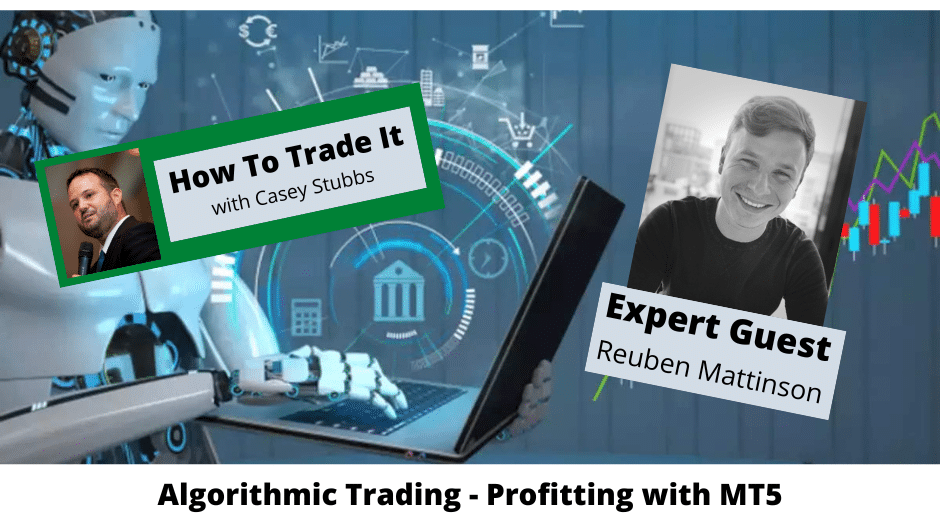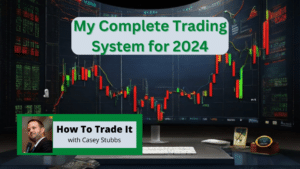Pioneering Profitable Algorithmic Trading with Reuben Mattinson of Puli Trading

The latest episode of the How to Trade It podcast, hosted by Casey Stubbs, features Reuben Mattinson from Puli Trading. Reuben shares his insights into automated algorithmic trading and discusses his journey into it. Algorithmic trading took Reuben nearly 10 years to master, and his journey required trial and error, thousands of strategies, extensive investment, and continuous development.
Reuben says that Puli Trading’s system is currently focused on 16 different currency pairs, with each pair employing three different strategies to adapt to different market conditions. These strategies include continuation, reversal within a trend, and swing trading strategies, providing diversification within their trading approach. You don’t want to miss it!
Click Play To Listen
Subscribe to How To Trade It
Casey inquires about risk management in currency trading, especially considering the challenges posed by leverage and sudden market spikes. Reuben highlights that their automated system incorporates a spread filter, and they set predetermined stop losses to mitigate risk. They also work with brokers having strong liquidity connections, ensuring stop losses are honored, except in catastrophic market scenarios.
Reuben describes their dynamic exit strategies, where their system learns from open trades, monitoring market reversals and adjusting to changing conditions. He emphasizes the importance of programmed strategies that can manage trades without human emotions coming into play.
When asked about AI, Reuben clarifies that while their system isn’t a sentient AI, it incorporates some AI-like elements. It continually analyzes market data, backtests it, and incorporates new data to refine their strategies. However, Reuben underlines the importance of not over-tweaking a system and finding a balance between automation and human intervention.
Casey raises the issue of taking profits and determining the best exit points, considering there are numerous options. Reuben explains that their dynamic exit strategies are programmed to take profits or cut losses based on specific conditions and indicators. This process is automated and avoids emotional decision-making.
Finally, Reuben discusses the challenges he faced in the 10-year journey to profitability, including the importance of stop losses, dynamic exit strategies, and the need to identify sustainable trading strategies. He mentions that he became consistently profitable after nine years of hard work, and in the last 12 months, their trading system has achieved 36% returns with a 15% drawdown, setting the stage for more success in the future with their updated algorithm.
Algorithmic Trading
Algorithmic trading, often referred to as algo trading, is a method of executing trades in financial markets using pre-programmed computer algorithms. These algorithms are designed to analyze various market variables, such as price, volume, and timing, and automatically generate buy or sell orders based on specific trading strategies or criteria.
Key components and characteristics of algorithmic trading include:
- Automated Decision-Making: Algo trading relies on computer programs to make trading decisions. These programs are designed to process large amounts of data and execute trades without human intervention.
- Speed and Efficiency: Algo trading systems can execute orders much faster than human traders, taking advantage of even tiny market fluctuations. This speed is critical in high-frequency trading (HFT).
- Trading Strategies: Algo trading can employ a wide range of trading strategies, such as trend-following, mean-reversion, arbitrage, and market-making. The choice of strategy depends on the trader’s objectives and risk tolerance.
- Risk Management: Algorithms often include risk management components to protect against significant losses. They may set stop-loss orders, limit exposure to specific positions, or dynamically adjust trading parameters.
- Backtesting: Before deployment, algo trading strategies are tested using historical data to assess their performance. This process, known as backtesting, helps refine and optimize strategies.
- Market Connectivity: Algo traders need direct access to financial markets and exchanges to execute trades swiftly and efficiently. They often use application programming interfaces (APIs) for connectivity.
- Liquidity Provision: Some algorithms are designed to provide liquidity to the market by placing passive limit orders. This is common in market-making strategies.
- Execution Algorithms: There are various execution algorithms tailored to specific objectives, like minimizing market impact or achieving the best possible price. These algorithms can be customized to meet the trader’s requirements.
- Regulatory Considerations: Algorithmic trading is subject to regulatory oversight in many jurisdictions. Rules and safeguards are in place to ensure market integrity and prevent market manipulation.
Algorithmic trading is widely used by institutional investors, hedge funds, and proprietary trading firms to execute large and complex trades efficiently. It has become a dominant force in modern financial markets, accounting for a substantial portion of trading volume across various asset classes, including stocks, options, futures, and foreign exchange.
Subscribe to How To Trade It
Connect with Reuben Mattinson:
- Website: https://pulitrading.com/
- YouTube: https://www.youtube.com/channel/UCpTwzxshG4IH2SeQFyns2Gw
- TicTok: https://www.tiktok.com/@pulitrading
- Facebook: https://www.facebook.com/pulitrading
- LinkedIn: https://www.linkedin.com/in/rjmtax/
- Instagram: https://www.instagram.com/pulitrading/
Connect with Casey:
- Website: https://caseystubbs.com
- YouTube: https://www.youtube.com/TradingStrategyGuides
- YouTube: https://www.youtube.com/caseystubbs
- Facebook: https://www.facebook.com/TradingStrategy
- LinkedIn: https://www.linkedin.com/in/caseystubbs
- Twitter: https://twitter.com/caseystubbs
- TradingStrategyGuides.com: https://www.tradingstrategyguides.com/
- Global Prop Trader: https://globalproptrader.com
- Email: podcast@tradingstrategyguides.com






